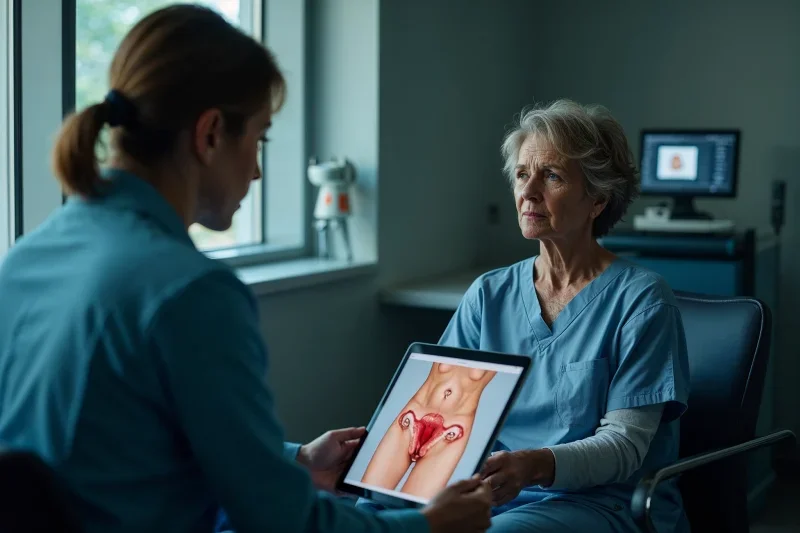Looking Back and Moving Forward: Addressing Regrets and Deciding to Untie Tubes
Categories:
By: Ethan Cole
Tubal ligation reversal decisions often stem from regret, influenced by unexpected life changes and evolving feelings about motherhood.
Emotional and psychological impacts post-tubal ligation can include sadness, anxiety, and a shift in identity due to lost fertility.
Partner and family support, open dialogue, and collective decision-making are crucial in the tubal ligation reversal process.
Modern reversal techniques like microsurgery and laparoscopy offer precision and less invasive options, with recovery involving both physical and emotional healing.
Counseling, support groups, and journaling can aid in managing emotions, providing a more informed and positive reversal experience.
Introduction
Addressing regrets and making a decision to reverse tubal ligation is a deeply personal journey, shaped by significant life alterations and profound emotional implications. It is not uncommon for women to experience remorse subsequent to tubal ligation, and there is an escalating number of women who are considering a reversal of the procedure. Should you decide to explore the options for reversal, be assured of societal and medical support. The recovery process following the reversal procedure entails coping with both physical discomfort and evolving emotional reactions. It is important to note that the probability of conception post-reversal is contingent upon a variety of individual factors. If you feel prepared to delve further into this matter, the path to comprehending these emotions and understanding the reversal procedure is open for exploration.
Introduction to Tubal Ligation and Reversal
You might think tubal ligation is a permanent decision, but is it really? There’s a growing trend that might surprise you: more and more women are choosing tubal ligation reversals. Let’s discuss this fascinating shift and what it could mean for you.
Understanding Tubal Ligation: A Permanent Decision?
While tubal ligation is often deemed a permanent decision, it’s not always the end of the road for women wishing to conceive. When you first decided to undergo this procedure, you may have been confident in your choice. But now, if you’re experiencing tubal ligation regret, know that you’re not alone. Many women grapple with the emotional impact of sterilization, realizing that their feelings about motherhood have evolved over time.
Deciding to untie tubes is a significant choice, and it’s important to understand what it entails. Tubal ligation, or “tying tubes,” involves blocking or sealing the fallopian tubes to prevent fertilization. It’s usually considered a permanent form of birth control, but it doesn’t have to be your final chapter.
If you’re mulling over the prospect of reversing your tubal ligation, you’re likely feeling a myriad of emotions. You’re not alone in this journey. Many women have walked this path before you, grappling with regret and yearning for another chance at motherhood. Remember, there’s no right or wrong decision here, only the choice that feels right for you.
The Growing Trend of Tubal Ligation Reversals
In recent years, a dramatic uptick in the number of women seeking tubal ligation reversals has marked a noticeable shift in reproductive health trends. Women like you are taking steps to reverse the decisions of their past, their reasons as unique as their lives.
The reasons for reversing tubal ligation are varied, ranging from changes in relationship status, increased financial stability, or simply the desire for more children. No matter your reason, it’s important to know that modern tubal ligation reversal techniques have made the process safer and more successful than ever before.
These advanced techniques, combined with a surge in societal and medical support for tubal reversal decisions, have made it possible for many women to reconsider their options. As a woman who may have had a tubal ligation, you might find yourself in a position where you want to explore these options.
Regret After Tubal Ligation: A Complex Emotional Journey
Feeling regret after tubal ligation isn’t uncommon and it’s a complex emotional journey that you might find yourself on. This is a result of the emotional and psychological impact of permanent sterilization, a decision that may seem right in a particular moment, but can change over time. Understanding why some women regret this decision and the factors that influence a change of heart can help you navigate your own feelings if you’re in a similar situation.
Why Some Women Regret Tubal Ligation
Regretting a decision as significant as tubal ligation can send you on a tumultuous emotional journey. The life changes after tubal ligation are sometimes unexpected and can cause a whirlwind of emotions. You might have thought you were ready to close the chapter on childbearing, but life has an uncanny way of throwing curveballs.
For some women, regret stems from a shift in family dynamics, like a new partner who wants children. Others may mourn the loss of their fertility as a part of their feminine identity. The anxiety about reversing tubal ligation can also be overwhelming, further fueling regret.
The psychological effects of tubal reversal may be intimidating. It’s not just about the physical process; it’s about grappling with past choices and future uncertainties. However, understanding the roots of your regret can help you navigate this intricate emotional terrain. Remember, you’re not alone in this journey. Many women grapple with similar feelings post-tubal ligation, and there are resources and support available to help you make sense of your emotions.
Emotional and Psychological Impact of Permanent Sterilization
While you may feel alone in your struggle with the emotional and psychological aftermath of permanent sterilization, it’s important to understand that you’re not. In fact, many women experience a complex emotional journey after tubal ligation, often marked by regret, sadness, and a longing for what could have been. This is a normal response, and it’s essential to allow yourself the time and space for emotional healing after sterilization.
Counseling for reproductive health choices can be a significant source of support during this time. Trained professionals can provide you with the tools and strategies to navigate through your feelings and work towards acceptance. They can also provide information about potential options, such as tubal reversal, that may contribute to life transformation for some women.
Factors That Influence a Change of Heart
In the aftermath of permanent sterilization, a change of heart isn’t uncommon. It can arise from varied factors, such as shifts in personal circumstances, a new partner with an aspiration of building a family after tubal reversal, or an overwhelming sense of regret.
You might feel your reproductive empowerment through tubal reversal is a path towards liberation. A chance to regain control over your fertility can be alluring, and the desire to expand your family can be a potent motivator. Maybe you’re grappling with the emotional implications of sterilization, yearning for another child, or simply desiring to reclaim your natural reproductive ability.
However, remember that fertility outcomes after tubal reversal aren’t guaranteed. Medical literature suggests a 40% to 80% chance of successful pregnancy post-reversal. Factors such as age, overall health, and the type of tubal ligation performed initially can influence your chances of success.
Life Changes That Drive the Decision to Reverse Tubal Ligation
You may find yourself in a new relationship with a desire to build a family together. Or, your decision may stem from a loss and the longing for emotional healing that a reversal might provide. Shifts in life goals and personal circumstances also play a significant role in the decision to reverse tubal ligation.
Building a Family After a New Relationship
After ending one chapter of your life, starting anew with a different partner often brings the desire for shared progeny. It’s a natural urge to want to create a unique bond between you and your new partner, a bond that’s biologically linked and emotionally enriching. You’ve likely considered reversing your tubal ligation, a decision you made in a different time, under different circumstances.
Now, you’re in a fresh relationship, one filled with promise and potential. You’re not alone in this journey, many have faced similar situations. As you contemplate this significant step, it’s vital to have an open dialogue with your partner. Discuss your shared vision for the future, your fears, and your aspirations.
Loss and Recovery: Emotional Healing Through Reversal
Life’s myriad changes can lead you to reevaluate past decisions, including the choice to have a tubal ligation. You’ve experienced loss—perhaps the loss of a child or a significant relationship—and you’re seeking recovery. That’s where tubal ligation reversal comes in.
This procedure isn’t just about physical healing; it’s also about emotional healing. It can be a cathartic step on your journey towards wholeness, a tangible way of reclaiming control over your body and your future. You’re not just reversing a surgery; you’re also reversing a decision that, in light of new circumstances, no longer fits with your life.
But remember, it’s not an easy fix. Emotional healing takes time, and it’s often a nonlinear process. You’ll have good days and bad days, periods of hope and periods of despair. That’s normal. It’s okay to grieve for what’s been lost, but don’t get stuck there. Look forward, not just backward. This reversal could be a powerful symbol of your resilience, your ability to adapt, and your determination to move past regret and towards a future that aligns with your now-changed life.
Shifts in Life Goals and Personal Circumstances
Personal circumstances and life goals are not static; they ebb and flow as you navigate the landscape of your life. Maybe you chose tubal ligation at a time when having more children didn’t align with your aspirations. You were sure, or so you thought. But life’s a funny thing, isn’t it?
Perhaps you’ve remarried, and your new partner wants to experience the joy of raising a child together. Or maybe your financial situation has drastically improved, and now you can afford to expand your family. It could be that the children you once had are grown, and an empty nest has you yearning for the pitter-patter of little feet again.
Life’s shifts can lead to a change of heart. Suddenly, the permanence of your decision to “tie your tubes” feels like a chain around your potential happiness. The good news is, it’s not a life sentence. Tubal reversal is a viable option, a way to untie the knots of past decisions. Remember, it’s your journey, and it’s absolutely okay to reroute.
Navigating the Decision to Untie Tubes
Deciding to untie your tubes can be a complex process, involving both medical and emotional considerations. You’re not alone in this, though - the support of your partner and family, as well as professional advice from medical experts, can help guide your decision. Let’s explore these facets and their essential role in your journey.
Evaluating the Medical and Emotional Implications
Before untangling the complexities of reversing tubal ligation, it is vital to comprehend both the medical and emotional implications of this decision. On the medical front, it is important to grapple with the reality that reversal surgery isn’t guaranteed to restore fertility. Your body’s response can be unpredictable, and factors such as age, overall health, and the type of tubal ligation performed initially, could all play a role in the success of the procedure.
Emotionally, it’s a heavy decision to make. The prospect of renewed fertility may bring hope, but there’s also the potential for disappointment if the surgery doesn’t yield the desired results. You may experience a rollercoaster of emotions from anticipation to anxiety, joy to potential sadness. It’s important to not only acknowledge these feelings but also to prepare for them.
In the end, it’s a personal decision that requires thorough evaluation. Seek counsel from trusted medical professionals, consider your emotional resilience, and weigh the potential benefits against the risks. You’re not merely deciding to untie tubes; you’re making a life-altering choice that requires deep introspection.
The Role of Partner and Family Support in the Decision
While maneuvering through this decision, the support of your partner and family can play an instrumental role. They’re not just spectators; they’re part of your journey. This isn’t just about you; it’s a collective decision that can impact everyone involved. Their input, understanding, and acceptance can make the process smoother and less stressful.
Open communication is key. Discuss your thoughts, fears, and hopes with them. Listen to their concerns, answer their questions, and allow them to express their emotions freely. It’s vital to keep the lines of dialogue open and honest. You’re not alone in this; their support can be your pillar of strength.
Furthermore, their perspectives can provide valuable insights that you might overlook. They might raise questions or considerations that hadn’t crossed your mind. It’s important to remember that their support doesn’t mean they make the decision for you. They’re there to guide, comfort, and stand by you, providing a safety net.
Consulting with Medical Experts to Understand Options
Alongside the backing of loved ones, enlisting the expertise of medical professionals is a vital next step in your journey to potentially untie your tubes. The intricate nature of this decision demands an extensive understanding of the medical implications, which can only come from consulting with experienced healthcare providers.
Start with a thorough discussion with your primary care physician or gynecologist. They’re equipped to provide a preliminary overview of your options and can refer you to a specialist if needed. A fertility expert or reproductive endocrinologist will dive deeper into the specifics, examining your unique health profile to determine the feasibility of the procedure.
The Surgical Process and Recovery Journey
Now that you’ve made your decision, you’re probably wondering about the next steps. Let’s explore the modern techniques used in tubal ligation reversal, understand what you can expect during your physical and emotional recovery, and discuss the long-term outcomes, particularly regarding fertility. It’s time to commence your surgical process and recovery journey.
Modern Techniques in Tubal Ligation Reversal
The journey to reclaiming your fertility begins with understanding the surgical process of tubal ligation reversal. Modern techniques have transformed this process, making it less invasive and more effective than ever before.
Microsurgical techniques are commonly used in tubal ligation reversal. Here, a skilled surgeon delicately removes the blocked portions of your fallopian tubes and reconnects the healthy sections. This is done under a high-powered microscope to guarantee precision and minimize any damage to your tubes.
Laparoscopic reversal, another recent advancement, uses small incisions and a camera to guide the surgeon. This method reduces your recovery time and the risk of complications.
Regardless of the technique, the goal is to restore your tubes’ function, giving you the chance to conceive naturally. However, success isn’t guaranteed. Factors like your age, overall health, and the type of ligation you had initially can affect the outcome.
What to Expect During Recovery: Physical and Emotional Healing
Your recovery journey after a tubal ligation reversal can be both physically and emotionally challenging. Immediately after surgery, you’ll experience some discomfort and grogginess as the anesthesia wears off. You’ll need to rest and avoid strenuous activity for a few weeks to allow your body to heal.
Pain is generally mild to moderate, but don’t hesitate to discuss pain management with your doctor. Everyone’s pain threshold is different and it’s crucial to guarantee your comfort during recovery. Bleeding and inflammation are normal, but if these symptoms worsen, seek immediate medical attention.
Emotionally, you may feel a roller coaster of emotions. It’s normal to feel relief, anxiety, and even apprehension about the future. You might worry about the success of the surgery or about potential complications. It’s important to open up about these feelings with your healthcare team or a counselor. Remember, you’re not alone in this journey.
Lastly, anticipate follow-up appointments. These are significant to monitor your healing progress and address any concerns.
Long-Term Outcomes: Fertility and Beyond
After making it through the initial recovery period, attention typically turns to the long-term outcomes of tubal ligation reversal, particularly regarding fertility. You’re likely keen to know what to expect.
Your chances of becoming pregnant post-reversal depend on multiple factors. Your age, the type of tubal ligation you underwent, the duration since your ligation, and your overall health—all play a significant role. Generally, the younger you are and the less time since your ligation, the higher your chances of conceiving again.
Remember, while the procedure opens the pathway for eggs to travel to the uterus, it doesn’t guarantee conception. However, with a successful reversal, your chances of natural conception could be as high as 80%.
Beyond fertility, tubal ligation reversal can also have psychological benefits. If your initial decision was made under stress or pressure, reversing it can bring emotional relief and a sense of control over your own body.
Psychological Considerations and Emotional Readiness
You’re not just considering a physical change; there’s also a psychological aspect to untying your tubes. It’s essential to manage your anxiety and expectations about the reversal, and that’s where counseling and support can be a significant help. Once you’ve embraced the decision and are ready to move forward, confidence in your choice is key.
Managing Anxiety and Expectations About Reversal
When considering tube reversal, it’s paramount to address the psychological aspects and emotional readiness that come with such a decision. The prospect of a reversal can be exciting, but it’s normal to experience anxiety about the outcome. It’s essential to manage these feelings to guarantee a positive journey.
You’re not alone if you’re feeling a mix of hope and apprehension. It may help to journal your thoughts and feelings. This can provide a release for any anxiety you’re experiencing and help you to identify patterns and triggers. Remember to be patient with yourself. The decision to untie your tubes was likely a significant one, so it’s understandable that reversing that decision is also weighty.
When it comes to expectations, it’s important to be realistic. A tube reversal is not a guaranteed path to pregnancy. Your age, health, and the type of tubal ligation you had initially can all affect the success rate. Educate yourself about the procedure, risks, and potential outcomes. Knowledge is power and can help alleviate some anxiety and set reasonable expectations. Finally, remember to listen to your gut. Only you can decide what’s right for your body and your future.
Counseling and Support for a Positive Journey
Traversing the emotional landscape that comes with a decision to untie your tubes can be challenging. It’s a journey that requires not only physical readiness but also emotional and psychological preparation. You might grapple with feelings of regret, anxiety, or uncertainty.
Seeking professional counseling is an essential step to navigate these emotions effectively. Counselors, therapists, or psychologists are equipped to aid you in processing your feelings and thoughts tied to this significant decision. They’ll provide a safe space for you to voice your concerns, fears, and expectations.
Support groups also play an important role in your journey. Engaging with others who’ve been in your shoes or are going through a similar experience can be incredibly comforting. They’ll offer empathy, advice, and reassurance that you’re not alone. They’ll also provide you with practical tips and insights rooted in their personal experiences.
Embracing the Decision: Moving Forward with Confidence
Taking the leap to untie your tubes is a monumental decision that demands emotional readiness. It’s not just about desire, but also about ensuring that you’re stable, secure, and confident enough to embrace the change. Remember, you’re not just reversing a physical procedure; you’re altering a life-long decision.
Emotionally, this can feel like you’re standing at the edge of a precipice, unsure of what lies ahead. It’s natural to feel a mix of excitement, anxiety, and even fear. The key is to channel these feelings into positive energy. Use them as a springboard to propel yourself forward with confidence. Don’t let uncertainty keep you stuck in a state of inaction.
Psychologically, take time to self-reflect. Assess your motivations, your desires, and your readiness to take on this new chapter in your life. Understand that it’s okay to have doubts and fears - they’re part of the human experience. But also recognize that you have the power to overcome them. Allow yourself to feel, to question, and to grow. This is your journey, and you have the strength to navigate it with confidence and grace.
The Broader Perspective: Reproductive Choices and Empowerment
Let’s now shift our focus to the wider context of reproductive choices and empowerment. It’s time to redefine family planning, emphasizing flexibility in reproductive health, and stressing the importance of informed decision-making. Furthermore, it’s essential to advocate for greater awareness around tubal reversal.
Redefining Family Planning: Flexibility in Reproductive Health
Flexibility, a cornerstone in the domain of modern family planning, empowers individuals to make informed decisions about their reproductive health. This paradigm shift signifies a departure from the traditional, rigid models of family planning that often failed to account for the fluid nature of human lives and aspirations.
With reproductive health now being viewed in a broader lens, you’re granted the freedom to plan your family based on your unique circumstances and desires. It’s no longer about adhering to societal norms or expectations, but about what works for you and your partner. This flexibility extends to all aspects of family planning, from conception to contraception, and even to the decision of reversing previous choices, like untangling your tubes.
The Importance of Informed Decision-Making
In the domain of reproductive health, being well-informed is your strongest tool for empowerment. Your decision-making process should be rooted in solid understanding. It’s not just about knowing your options; it’s about comprehending the long-term implications of each choice.
Consider the decision to untie tubes, for example. You’re not merely deciding on a procedure; you’re making a choice that impacts your future family structure and your personal health. It’s essential to be cognizant of the potential risks, benefits, and the overall success rate. The more informed you are, the better prepared you’ll be to handle the outcome, whatever it may be.
Advocating for Greater Awareness Around Tubal Reversal
Awareness around tubal reversal—a lifeline for those who wish to conceive after sterilization—needs a serious boost. You’re not alone if you’re unfamiliar with this procedure. It’s a chance for women who’ve undergone sterilization to regain their fertility. However, the lack of awareness and understanding about it can lead to missed opportunities and unfulfilled dreams.
You can play an essential role in changing this scenario. Begin by educating yourself about tubal reversal. You’ll find that it’s not just a medical procedure, but a beacon of hope for many. Once you’ve understood its importance, share your knowledge. Talk about it with your circle, post about it on social media, and discuss it in forums.
Moreover, advocate for more discussions about reproductive choices in healthcare settings. Encourage professionals to provide thorough information about all options, including tubal reversal. Remember, you’re not just advocating for a procedure, but for the empowerment of women to make informed decisions about their bodies.
Let’s bring tubal reversal into the spotlight. After all, knowledge is power, and it has the potential to change lives.
Conclusion
After journeying through the emotional landscape of regret and the complex decision-making process of tubal ligation reversal, it’s clear that this path isn’t a straightforward one. You’ve explored the intricacies of regret, understood its nuances, and realized it’s a natural part of the human experience. You’ve also navigated the maze of decision-making, grappling with the multifaceted aspects of tubal ligation reversal.
However, your journey doesn’t end here. It’s essential you continue to educate yourself and others about these topics, fostering a deeper understanding within your community. It’s not just about personal growth; it’s about collective enlightenment. It’s about empowering yourself and those around you.
In all this, remember: regret isn’t a life sentence. It’s a catalyst for change. Equally, deciding to untie your tubes isn’t a decision taken lightly. It’s a transformative choice, one that warrants careful consideration and informed understanding. Ultimately, the power rests in your hands. With knowledge as your compass, and courage as your guide, you can navigate this journey, addressing your regrets and making the choices that are right for you.
Ultimately, the power rests in your hands. With knowledge as your compass and courage as your guide, you can navigate this journey, addressing your regrets and making choices that are right for you. At Dr. Jason Neef’s practice, we are here to support you with expertise and compassion, helping you make informed decisions that align with your goals and aspirations.
Call now to schedule an appointment with Dr. Jason Neef and explore your fertility options.
Call (817) 568-8731Categories:
Frequently Asked Questions
-
Tubal sterilization is a sterilization procedure that permanently blocks or seals the ends of the fallopian tubes to prevent fertilization. It’s considered permanent, but for women wishing to get pregnant again, a tubal reversal procedure may restore fertility.
-
Yes, women who regret having their tubes tied can opt for a tubal reversal procedure, provided they are a good candidate for tubal reversal. A tubal reversal doctor evaluates factors like medical records, age, and the presence of scar tissue to determine suitability.
-
A web-based decision aid can increase knowledge about tubal sterilization by presenting key facts about tubal sterilization methods, helping women understand potential outcomes and reducing regret after the decision.
-
Women who undergo tubal reversal surgery have a higher risk of ectopic pregnancy, where a fertilized egg implants outside the uterus. Regular monitoring by a fertility specialist is essential to ensure a healthy pregnancy.
-
Tubal ligation surgery permanently blocks the tubes to prevent pregnancy, while tubal anastomosis is a tubal reversal operation that reconnects the ends of the fallopian tubes to restore natural fertility.
-
Not all women are candidates for a successful tubal reversal. Factors like the type of sterilization procedure, the condition of the tubes untied, and whether scar tissue is present play a role in determining candidacy for a tubal reversal.
-
A randomized controlled trial examines the success rates of tubal reversal surgery, including methods like tubal anastomosis, and evaluates the impact on outcomes like pregnancy within a specific timeframe.
-
Women should understand that tubal sterilization is considered permanent, though reversal may be the answer for some. Using a web-based decision aid to increase knowledge can help clarify the key aspects of tubal sterilization.
-
Insurance often doesn’t provide coverage for tubal reversal procedures. Women interested in reversing their tubes tied should consult a tubal reversal doctor about the cost of a tubal reversal and financing options.
-
Women can get pregnant within 6-12 months following a successful tubal reversal. Factors like age, ends of the fallopian tubes, and overall reproductive health influence the chance of getting pregnant after surgery.











